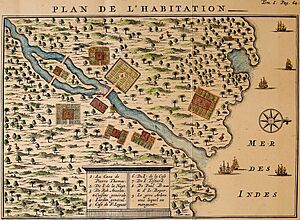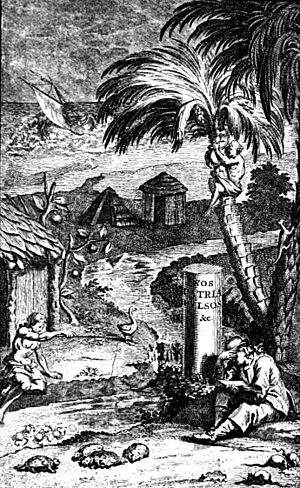François Leguat facts for kids
François Leguat (born 1637 or 1639 – died September 1735) was a French explorer and naturalist. He was part of a small group of French Protestant refugees. In 1691, they settled on the island of Rodrigues in the western Indian Ocean, which was not inhabited at the time.
After living on the island for two years, the colonists became unhappy. They managed to escape to Mauritius in a small boat. Leguat returned to Europe in June 1698. He wrote a book about his adventures, which was published in 1708. In his book, Leguat described several types of birds and tortoises. These animals lived only on Rodrigues (endemic) but are now extinct.
Contents
Who Was François Leguat?
François Leguat was a French Huguenot. This means he was a Protestant from France. He was from a region called Bresse, which is now part of Ain. In 1685, the Edict of Nantes was cancelled. This meant Protestants in France lost their rights to practice their religion freely. Because of this, Leguat fled to Holland in 1689.
A New Home in the Indian Ocean
A French nobleman, Marquis Henri du Quesne, had written good things about the island of Réunion. He planned to start a colony there for French Protestant refugees. The Dutch East India Company helped him. Many refugees, including Leguat, wanted to join this new colony.
However, du Quesne found out that France had sent ships to Réunion. He did not want any fighting with the French. So, he changed his plan. He prepared a small ship called L'Hirondelle. He told the captain, Anthony Valleau, to explore the Mascarene islands. The captain was to claim any island that was empty and good for a colony. It seems the colonists were not told about this change.
On July 10, 1690, Leguat and nine other men boarded L'Hirondelle in Amsterdam. They believed they were going to start a new life on Réunion. But on May 16, 1691, Leguat and seven of his friends were left on the empty island of Rodrigues.
Life on Rodrigues Island

After living on Rodrigues for a year, the group started to miss their homes. They decided to build a wooden boat. Their goal was to escape to the island of Mauritius, which was controlled by the Dutch at the time.
Their first attempt to leave failed. Their boat hit Rodrigues' reef. One person in the group later died from an illness. This illness might have come from touching poisonous animals on the reef. They finally left Rodrigues on May 21, 1693. They spent a week traveling in their open boat. The wind and ocean currents carried them 300 nautical miles (560 km) to Mauritius.
Trouble in Mauritius
At first, the Governor of Mauritius, Rodolfo Diodati, welcomed them. But things changed after an argument. The group had brought a valuable substance called ambergris from Rodrigues. The Governor also found out they planned to steal a small boat and escape to Réunion. Because of this, five of the group were put in prison.
Relations were probably difficult because France and Holland were fighting in the Nine Years' War (1688–97). In February 1694, the prisoners were moved to a tiny island far from the shore. They were kept in very bad conditions. One person died trying to escape. He seemed to have reached the main island of Mauritius but then died in the woods.
Finally, in September 1696, the remaining group members were sent to Batavia (now Jakarta, Indonesia). They appeared before the Dutch Council and were found to be innocent. Leguat and the two other survivors returned to Europe in June 1698. Leguat seems to have settled in England and lived there for the rest of his life. He passed away in London in September 1735.
Leguat's Book and Discoveries
Leguat published a book about his adventures in 1708, when he was about 70 years old. The full French title was very long: Voyage et avantures de François Leguat et de ses compagnons, en deux isles désertes des Indes orientales : avec la relation des choses les plus remarquables qu'ils ont observées dans l'isle Maurice, à Batavia, au Cap de Bon Espérance, dans l'isle de Sainte Hélène, et en d'autres endroits de leur route. Le tout enrichi de cartes et de figures.
The French version was published in both London and Amsterdam. An English translation, called A New Voyage to the East-Indies, was published in London. A Dutch version was published in Utrecht. Some parts of Leguat's book are very similar to writings by Maximilien Misson, another French Protestant living in exile. It's possible that Misson helped Leguat write the book and even wrote the introduction.
Leguat's book is very important because it describes animals that are now extinct. These animals lived only on Rodrigues island. They include:
- The Rodrigues solitaire (a large, flightless bird)
- The Rodrigues rail (another flightless bird)
- The domed Rodrigues giant tortoise
- The saddle-backed Rodrigues giant tortoise
- Newton's parakeet


